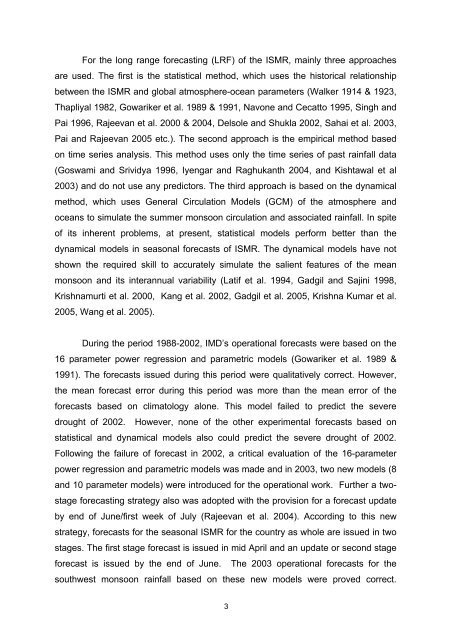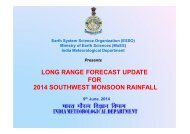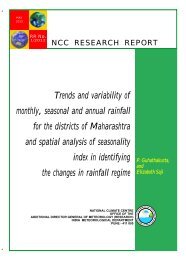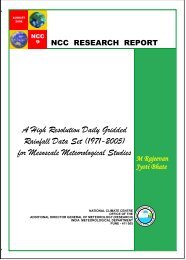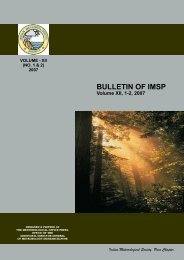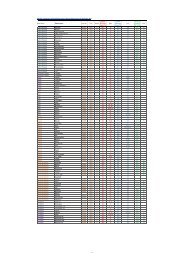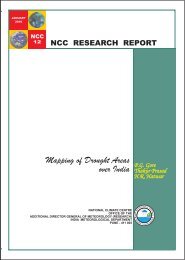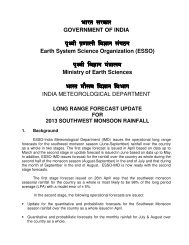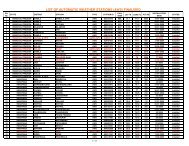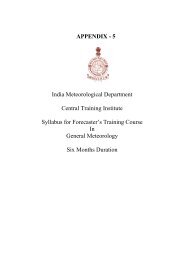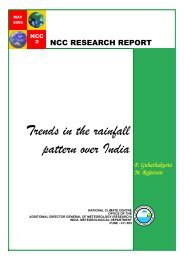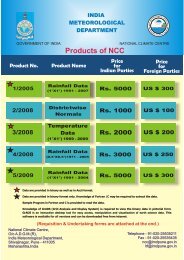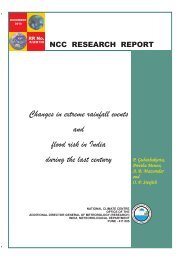NCC Report No. 1 - (IMD), Pune
NCC Report No. 1 - (IMD), Pune
NCC Report No. 1 - (IMD), Pune
You also want an ePaper? Increase the reach of your titles
YUMPU automatically turns print PDFs into web optimized ePapers that Google loves.
For the long range forecasting (LRF) of the ISMR, mainly three approachesare used. The first is the statistical method, which uses the historical relationshipbetween the ISMR and global atmosphere-ocean parameters (Walker 1914 & 1923,Thapliyal 1982, Gowariker et al. 1989 & 1991, Navone and Cecatto 1995, Singh andPai 1996, Rajeevan et al. 2000 & 2004, Delsole and Shukla 2002, Sahai et al. 2003,Pai and Rajeevan 2005 etc.). The second approach is the empirical method basedon time series analysis. This method uses only the time series of past rainfall data(Goswami and Srividya 1996, Iyengar and Raghukanth 2004, and Kishtawal et al2003) and do not use any predictors. The third approach is based on the dynamicalmethod, which uses General Circulation Models (GCM) of the atmosphere andoceans to simulate the summer monsoon circulation and associated rainfall. In spiteof its inherent problems, at present, statistical models perform better than thedynamical models in seasonal forecasts of ISMR. The dynamical models have notshown the required skill to accurately simulate the salient features of the meanmonsoon and its interannual variability (Latif et al. 1994, Gadgil and Sajini 1998,Krishnamurti et al. 2000, Kang et al. 2002, Gadgil et al. 2005, Krishna Kumar et al.2005, Wang et al. 2005).During the period 1988-2002, <strong>IMD</strong>’s operational forecasts were based on the16 parameter power regression and parametric models (Gowariker et al. 1989 &1991). The forecasts issued during this period were qualitatively correct. However,the mean forecast error during this period was more than the mean error of theforecasts based on climatology alone. This model failed to predict the severedrought of 2002. However, none of the other experimental forecasts based onstatistical and dynamical models also could predict the severe drought of 2002.Following the failure of forecast in 2002, a critical evaluation of the 16-parameterpower regression and parametric models was made and in 2003, two new models (8and 10 parameter models) were introduced for the operational work. Further a twostageforecasting strategy also was adopted with the provision for a forecast updateby end of June/first week of July (Rajeevan et al. 2004). According to this newstrategy, forecasts for the seasonal ISMR for the country as whole are issued in twostages. The first stage forecast is issued in mid April and an update or second stageforecast is issued by the end of June. The 2003 operational forecasts for thesouthwest monsoon rainfall based on these new models were proved correct.3


